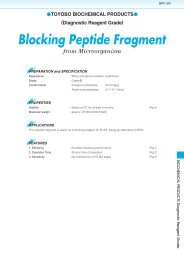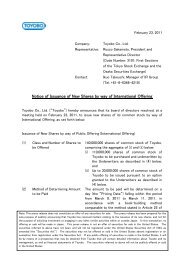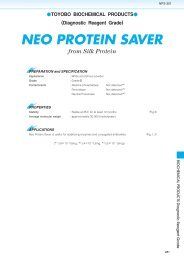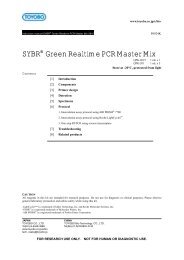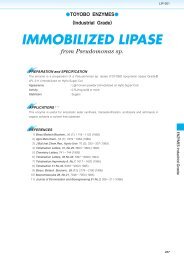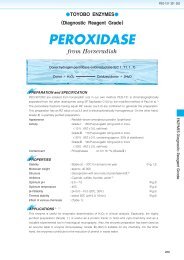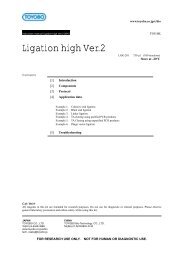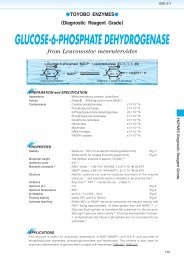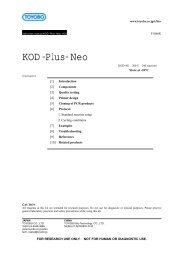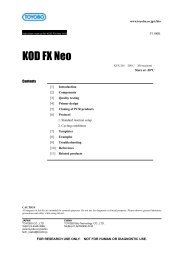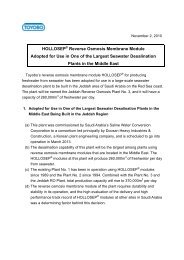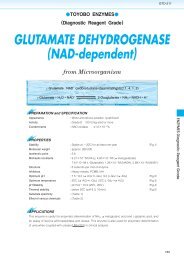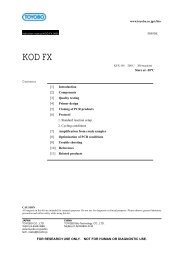GLA-111 - Toyobo
GLA-111 - Toyobo
GLA-111 - Toyobo
You also want an ePaper? Increase the reach of your titles
YUMPU automatically turns print PDFs into web optimized ePapers that Google loves.
<strong>GLA</strong>-<strong>111</strong><br />
TOYOBO ENZYMES<br />
(Diagnostic Reagent Grade)<br />
GLUCOAMYLASE<br />
from Rhizopus sp.<br />
1,4--D-Glucan glucohydrolase (EC 3.2.1.3)<br />
Starchn H 2 O<br />
n -D-Glucose<br />
PREPARATION and SPECIFICATION<br />
Appearance<br />
: White amorphous powder (salt-free), lyophilized<br />
Activity<br />
: Grade30U/mg-solid or more<br />
PROPERTIES<br />
Stability : Stable at 20 for at least 6 months Fig.1<br />
Molecular weight<br />
: approx. 70,000 1<br />
Michaelis constants 1 : <strong>111</strong>.110 4 M (Maltose), 3.60.5110 4 M (Maltotriose),<br />
2.50.3310 4 M (Maltotetraose), 1.60.0210 4 M (Maltopentaose)<br />
Structure : GlycoproteinE<br />
280nm<br />
1cm<br />
(1%)14.5<br />
Optimum pH : 4.55.0 Fig.2<br />
Optimum temperature : 60 Fig.3<br />
pH Stability : pH 4.08.5 (25, 20hr) Fig.4<br />
Thermal stability : below 45 (pH 5.5, 10min) Fig.5<br />
Substrate specificity 1,2 : This enzyme completely hydrolyzes soluble starch, amylopectin,<br />
glycogen,-or-limit dextrin, amylose, maltooligosaccharides and<br />
panose.<br />
APPLICATIONS<br />
This enzyme is useful for structural investigation of carbohydrates and for enzymatic determination of<br />
-amylase when coupled with the related enzymes in clinical analysis.
<strong>GLA</strong>-<strong>111</strong><br />
ASSAY<br />
Principle:<br />
Starchn H 2 O<br />
glucoamylase<br />
n GlucoseDextrin<br />
The formation of glucose is measured as reducing sugar by the modified Fehling-Lehmann-Schoorl method.<br />
Unit definition:<br />
One unit causes the formation of ten milligrams of glucose in 30 minutes under the conditions described below.<br />
Method:<br />
Reagents<br />
A. Starch solution<br />
B. Alkaline solution<br />
C. CuSO 4 Solution<br />
D. KI solution<br />
E. H 2 SO 4 Solution<br />
F. Na 2 S 2 O 3 Solution<br />
G. Enzyme diluent<br />
1.0%Suspend 1.0g of soluble starch (Merck) in 90ml of H 2 O, dissolve by boiling<br />
for 3min and cool down to room temperature. Add 5.0ml of 1.0M acetate buffer, pH<br />
4.5 and fill up to 100ml with H 2 O. (Should be prepared fresh)<br />
100g NaOH, 365g Rochelle salt4H 2 O/1,000ml of H 2 O<br />
7.0% (70g CuSO 4 5H 2 O/1,000ml of H 2 O)<br />
30% (300g KI/1,000ml of H 2 O)(Store in a brownish bottle)<br />
25%<br />
50mM (49.638g Na 2 S 2 O 3 5H 2 O, 4.0g Na 2 CO 3 (stabilizer)/4,000ml of H 2 O)(Store in<br />
a brownish bottle and keep for 34 days before use)<br />
10mM acetate buffer, pH 4.5<br />
Procedure<br />
1. Pipette 4.0ml of substrate solution (A) into a test tube (32<br />
Concentration in assay mixture<br />
200mm) and equilibrate 40 for about 5minutes.<br />
Acetate buffer<br />
42 mM<br />
2. Add 1.0ml of the enzyme solution and mix.<br />
Starch<br />
0.8<br />
3. After exactly 15 minutes at 40, add 2.0ml of alkaline solution (B) stop the reaction.<br />
At the same time, prepare the blank by first mixing the substrate solution with 2.0ml of alkaline solution<br />
after 15min-incubation at 40, followed by addition of the enzyme solution.<br />
4. Add 2.0ml of CuSO 4 solution (C) and, after covering the test tube with a marble (40mm) to prevent<br />
evaporation, place the test tube in a boiling water bath.<br />
5. After 20 minutes, remove the test tube from a boiling water bath and cool down to room temperature under<br />
running water.<br />
6. Add 2.0ml each of KI solution (D) and H 2 SO 4 solution (E) in this order.<br />
7. Shake the test tube and determine the amount of residual Cu by titration with Na 2 S 2 O 3 solution (F).<br />
8. Record the titers (ml) of the test (t) and the blank (b), and calculate the titration difference in ml (<br />
sample:bt).<br />
<br />
Dissolve the enzyme preparation in ice-cold distilled water and dilute to 0.41.5U/ml with enzyme diluent<br />
(G), immediately before assay.<br />
Calculation<br />
Activity can be calculated by using the following formula<br />
sample30mindf sample<br />
Volume activity (U/ml) 2.0df<br />
glucose15min glucose<br />
Weight activity (U/mg)(U/ml)1/C<br />
glucose Titration difference (ml) for ten miligrams of glucose (Determine the titration difference by using<br />
glucose standard solution (5.0mg/ml) instead of the enzyme solution under the above assay<br />
conditions.)<br />
df Dilution factor<br />
C Enzyme concentration in dissolution (c mg/ml)<br />
REFERENCES<br />
1) K.Hiromi, Y. Nitta, C.Numata and S.Ono; Biochim.Biophys.Acta, 302, 362 (1973).<br />
2) J.Fukumoto; Protein, Nucleic Acid and Enzyme, 4, 3 (1959).
<strong>GLA</strong>-<strong>111</strong><br />
100<br />
100<br />
100<br />
Residual Activity,%<br />
50<br />
-20<br />
5<br />
20<br />
37<br />
Relative Activity<br />
50<br />
Residual Activity, %<br />
50<br />
0 2 4 6 8 10 12<br />
Period (months)<br />
Fig.1. Stability (Powder form)<br />
kept under dry conditions<br />
0 2 4 6 8<br />
pH<br />
Fig.2. pH-Activity<br />
40,15min-reaction in 50mM buffer<br />
solution: pH2.0,sodium acetate-HCI;<br />
pH3.0-6.0,acetate;pH6.0-8.0,<br />
phosphate<br />
0 2 4 6 8 10<br />
pH<br />
Fig.4.pH-Stability<br />
25,20hr-treatment with 50mM<br />
buffer solution: pH3.0-6.0 acetate;<br />
pH6.0-9.0,phosphate;pH9.0-11.0,<br />
borate<br />
Relative Activity<br />
100<br />
50<br />
Residual Activity, %<br />
100<br />
50<br />
0 40 50 60 70<br />
Temperature, <br />
Fig.3.Temperature activity<br />
15min-reaction in 50mM acetate<br />
buffer,pH4.5<br />
0 40 50 60<br />
Temperature, <br />
Fig.5.Thermal stability<br />
10min-treatment with 50mM<br />
acetate buffer,pH5.5
<strong>GLA</strong>-<strong>111</strong><br />
<br />
<br />
glucoamylase<br />
2 <br />
<br />
<br />
<br />
<br />
<br />
<br />
<br />
P<br />
<br />
PP<br />
<br />
<br />
2 <br />
P<br />
4 2 <br />
P<br />
<br />
P<br />
<br />
<br />
2 2 3 2 2 3<br />
<br />
P<br />
<br />
<br />
<br />
P<br />
<br />
P<br />
<br />
P<br />
<br />
P<br />
P<br />
<br />
<br />
P P<br />
<br />
<br />
<br />
P<br />
P<br />
P<br />
<br />
<br />
P<br />
<br />
<br />
<br />
<br />
<br />
<br />
<br />
P <br />
<br />
P<br />
<br />
<br />
P



